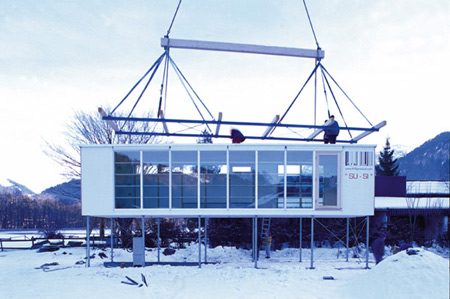Yesterday we covered a slideshow essay at Slate that criticized the current "prefab fad." Rybczynski has a 3 part indictment:
"unpopular, expensive and divorced from industrial production".We're not sure whether he's paying attention.
As for "unpopular", Modernist homes (prefab or otherwise) are aimed at a specific audience:
"Where are all these people who live in cool lofts and spaces in the city supposed to go when they move to the country? They certainly don't want to go live in a colonial-style house." (Robert Luntz of Resolution: 4, quoted in Builder Online)
It's unlikely that modernist prefab will sweep away the dominant preference for traditional homes. But it could easily become a profitable (self-sustaining) niche. Our favorite example is the one that we (Peter and Scott) are using to create and edit this post: the Macintosh still has less than 10% overall market share but represents a thriving business that continues to dominate several niche markets.
Prefab doesn't just mean modernist, e.g.  Hive Modular offers a (mostly) traditional facade,
Hive Modular offers a (mostly) traditional facade,  Empyrean's Deck House and Acorn are classic "post and beam", and the "traditional" modular housing industry is growing.
Empyrean's Deck House and Acorn are classic "post and beam", and the "traditional" modular housing industry is growing.
The current crop of prefab architects want to make "good design" more affordable.
"Most architects working in prefab are trying to create standard designs, to reduce the cost and risk to the client, and bring the services of talented architects to smaller houses." (Lloyd Alter on Treehugger, quoted in May)
"While her first customers tended to fit the stereotype of the Prius-driving, NPR-listening eco-consumer, Kaufmann is increasingly fielding inquiries from people who just want an attractive, affordable house." (From an article on Michelle Kaufmann in July.)
Last point: prefab is not "divorced from industrial production". Many of the companies we cover have built their own factories and most others are working closely with existing factories.
Has the prefab industry achieved its goals? No. Is it headed in the right direction? We think so.


I'm not sure whether the free market even enters into the equation given the stranglehold of local zoning laws. In any case, my approach to these issues is very pragmatic: don't let the perfect be the enemy of the good. Pursue incremental progress: more affordable, more green, more aesthetic.
As an engineer, I'm pretty sure that moving ever larger amounts of construction into the factory can play an important role. But, to echo Lloyd, the ultimate change has to come in what sort of housing people want to pay for (and live next to).
If Rybcynski is correct about one thing, it's that the tendancy of the architectural design community to prefer austere and elusive esthetics acquired from the modernist academy. The overall appearance is elitist at least in an intellectual way, and to a large percentage of American homebuyers this is big deterrent. Though I adore these tidy specimens of crisp modernism, I know that the industry overall is poorly served by allowing these Dwell magazine prizewinners to champion the national cause. Please know that the homes showcased in both of Sherri Koones' books, and the home built by Michael Buchanan and featured on the Bob Vila show and in Buchanan's book offer more of what the majority of American homebuyers will prefer, and this is actually great news for the modernists.
We haven't (yet!) covered Buchanan's PreFab Home though did cover Koones's Prefabulous and some videos from Bob Vila.
Unfortunately, the trend you're referring to won't divert it's course until we begin to see much more of what MKD is doing in the state of Colorado, and what's been going on in London for some time now. I honestly see no cost advantage to choosing prefabration over a site-built home if the homeowner plans to build on an urban site, and especially if the homeowner desires something other than the usually awful catalog selections that manufacturers typically offer. Single owner sale + urban lot + non-catalog custom plan = no measurable savings.
Prefabrication really makes sense when one considers the entire purpose of the object as created by an industrial process. Industrial process generally implies mass production of identical component parts with a high degree of precision and low tolerance for anomoly. Considering the massive overhead carried to equip an industrial process, the numbers don't add up until there is high enough revenue-generating output. I believe prefabrication, whether sectional modular or panilized, will really pay off when developers see its value in clustered developments either 2-3 in number in close proximity, or entire blocks or neighborhoods. There is simply NO WAY that production housing can compete with prefabrication when building multiple units per development. The materials acquisition (b/c of small on-site storage capabilities) and labor cost alone would sink a conventional builder, and with our desperate need to retard low-density sprawl and reinvigorate our metropolitan cores prefabrication deserves a serious look. Long live those who continue to believe that well-built and well-designed homes can be truly affordable to those who are the most in need.